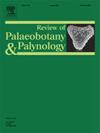A Paleocene occurrence of cornelian cherries Cornus subg. Cornus in the land-mammal site of Berru (Paris Basin, France)
IF 1.7
3区 地球科学
Q2 PALEONTOLOGY
引用次数: 0
Abstract
Cornus subgenus Cornus, also called cornelian cherries, is a relatively ancient clade of dogwoods with a complex biogeographic history. Their fossil record attests to a distribution in North America during the Late Cretaceous and Paleocene, whereas the earliest fossil record in Europe is dated as early as the Eocene. Here, we describe a new occurrence of cornelian cherries based on permineralized endocarps from the late Paleocene (ca. 58 Ma) land-mammal locality of Berru, in Northwest France. The 48 studied specimens possess characteristic cornelian cherry endocarp morphology with locules associated with a dorsal germination valve, no central vascularization, and the presence of numerous secretory cavities in the endocarp wall. In addition, the presence of (three)-four locules and a large apical depression strongly suggest affinities with the early Eocene species Cornus multilocularis from the London Clay Formation. This new occurrence expands the stratigraphic range of the species by approximately four to six million years and is the first unequivocal evidence of cornelian cherries in Europe during the Paleocene. The biogeographical history of cornelian cherries remains complex to explore because of its ancient distribution in the Cretaceous and a geographically and stratigraphically patchy Cenozoic record.
山茱萸古新世的一次发现。法国巴黎盆地Berru陆生哺乳动物遗址的山茱萸
山茱萸亚属山茱萸,也被称为山茱萸,是山茱萸的一个相对古老的分支,具有复杂的生物地理历史。它们的化石记录证明了它们在晚白垩纪和古新世在北美的分布,而欧洲最早的化石记录可以追溯到始新世。本文基于古新世晚期(约58 Ma)陆生哺乳动物Berru地区的过矿化内腕骨,描述了一种新出现的山茱萸。所研究的48个标本具有典型的山茱萸内果皮形态,有与背侧萌发阀相关的小室,没有中央血管化,内果皮壁存在许多分泌腔。此外,(3)- 4个房室的存在和一个大的顶凹强烈表明它与伦敦粘土组的早始新世物种Cornus multilocularis相似。这一新发现将该物种的地层范围扩大了大约400万到600万年,并且是古新世时期欧洲第一个明确的证据。山茱萸的生物地理历史仍然很复杂,因为它在白垩纪的古老分布和新生代的地理和地层记录是不完整的。
本文章由计算机程序翻译,如有差异,请以英文原文为准。
求助全文
约1分钟内获得全文
求助全文
来源期刊
CiteScore
3.50
自引率
21.10%
发文量
149
审稿时长
6 months
期刊介绍:
The Review of Palaeobotany and Palynology is an international journal for articles in all fields of palaeobotany and palynology dealing with all groups, ranging from marine palynomorphs to higher land plants. Original contributions and comprehensive review papers should appeal to an international audience. Typical topics include but are not restricted to systematics, evolution, palaeobiology, palaeoecology, biostratigraphy, biochronology, palaeoclimatology, paleogeography, taphonomy, palaeoenvironmental reconstructions, vegetation history, and practical applications of palaeobotany and palynology, e.g. in coal and petroleum geology and archaeology. The journal especially encourages the publication of articles in which palaeobotany and palynology are applied for solving fundamental geological and biological problems as well as innovative and interdisciplinary approaches.

 求助内容:
求助内容: 应助结果提醒方式:
应助结果提醒方式:


